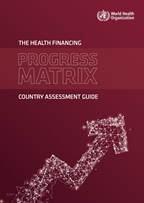Revenue Raising
Overview
Making progress towards UHC requires health systems to rely predominantly on public revenue sources, given their central importance to reducing unmet health needs at the same time as improving financial protection.
Ensuring a stable, predictable flow of funds to purchasing agencies and service providers is crucial, and makes raising revenues have considerable overlap with the public financial management agenda.
Demonstrating improved efficiency in spending is also important to revenue discussions, and here there is overlap with issues of purchasing arrangements and benefit design.

Desirable attributes in revenue raising policy
As part of the development of the Health Financing Progress Matrix, four desirable attributes of health revenue raising policy were developed, representing a synthesis of both theoretical and empirical evidence. Each represents a destination, and hence a direction for policy.
- Health expenditure is based predominantly on public/compulsory funding sources
- The level of public (and external) funding is predictable over a period of years
- The flow of public (and external) funds is stable and budget execution is high
- Fiscal measures are in place that create incentives for healthier behaviour by individuals and firms
For each desirable attribute, a number of questions are used to assess the situation in a country as detailed below. In some cases, one question informs several attributes:
Health expenditure is based predominantly on public/compulsory funding sources
- Does your country’s strategy for domestic resource mobilization reflect international experience and evidence? (Q2.1)
- How predictable is public funding for health in your country over a number of years? (Q2.2)
- How stable is the flow of public funds to health providers? (Q2.3)
- To what extent are the different revenue sources raised in a progressive way? (Q2.4)
The level of public (and external) funding is predictable over a period of years
- How predictable is public funding for health in your country over a number of years? (Q2.2)
- Are processes in place for health authorities to engage in overall budget planning and multi-year budgeting? (Q6.3)
The flow of public (and external) funds is stable and budget execution is high
- How stable is the flow of public funds to health providers? (Q2.3)
- Do health budget formulation and implementation support alignment with sector priorities and flexible resource use? (Q6.2)
- Are processes in place for health authorities to engage in overall budget planning and multi-year budgeting? (Q6.3)
- Are there measures to address problems arising from both under- and over-budget spending in health? (Q6.4)
Fiscal measures are in place that create incentives for healthier behaviour by individuals and firms
- To what extent does government use taxes and subsidies as instruments to affect health behaviours? (Q2.5)
Further details on each question can be found in the HFPM Country Assessment Guide, explaining in more details why it is important, and what it means to make progress on this issue.
Potential policy issues
Some key policy issues are outlined below:
- Public revenues are compulsory (or mandatory), prepaid and pooled; meaning that revenues are collected before the need for individual care is identified and accessed. Most commonly, these are direct and indirect taxes, as well as those earmarked for health (e.g. health insurance contributions).
- One objective of revenue raising is fairness in the way revenues are raised, or how the burden falls across the population; out-of-pocket payments are almost always a regressive way to fund health services. Each source of revenue has a different impact on equity in finance as discussed in the case of the Republic of Ireland.
- How much public spending is enough? Efforts have been made to estimate a level of public spending required to move towards universal health coverage. These include US$86 per capita (2012) or at least 5% of GDP, at least 6% of GDP, and at least 15% of total government spending. However, work by WHO suggests that even at very low levels of spending, countries can make significant progress towards universal health coverage (UHC).
Revenue raising policy needs to be coordinated with pooling and purchasing arrangements to strengthen the positive impact on health system performance.
Publications
All →Governments should aim to move towards a predominant reliance on public funding for health, as evidence shows this increases access to health services...
Spending targets for health: no magic number
In the context of discussions on health spending targets, this paper analyses not only how much countries spend on health, but how they perform in terms...

Country assessment guide: the Health Financing Progress Matrix
This document provides detailed advice in support of implementation of version 2.0 of the Health Financing Progress Matrix (HFPM) released in December...
The World Health Report 2010
Promoting and protecting health is essential to human welfare and sustained economic and social development. This was recognized more than 30 years...
Fiscal space, public financial management, and health financing: sustaining progress towards UHC: implementation...
In April 2016, WHO’s Department of Health Systems Governance and Financing convened a follow-up meeting to bring together representatives...
Fiscal space, public finance management and health financing policy: a collaborative agenda
Between 9-11 December 2014, WHO convened a meeting of public finance and health financing policy experts and practitioners to discuss a number of topics...
e-Learning course on Health Financing Policy for UHC
Activities
Related health topics
Contact Us

.jpg?sfvrsn=db321f5e_2)